Joaquin Gonzalez-Rodriguez
Exploring Large Protein Language Models in Constrained Evaluation Scenarios within the FLIP Benchmark
Jan 30, 2025



Abstract:In this study, we expand upon the FLIP benchmark-designed for evaluating protein fitness prediction models in small, specialized prediction tasks-by assessing the performance of state-of-the-art large protein language models, including ESM-2 and SaProt on the FLIP dataset. Unlike larger, more diverse benchmarks such as ProteinGym, which cover a broad spectrum of tasks, FLIP focuses on constrained settings where data availability is limited. This makes it an ideal framework to evaluate model performance in scenarios with scarce task-specific data. We investigate whether recent advances in protein language models lead to significant improvements in such settings. Our findings provide valuable insights into the performance of large-scale models in specialized protein prediction tasks.
Secure access system using signature verification over tablet PC
Jan 11, 2023Abstract:Low-cost portable devices capable of capturing signature signals are being increasingly used. Additionally, the social and legal acceptance of the written signature for authentication purposes is opening a range of new applications. We describe a highly versatile and scalable prototype for Web-based secure access using signature verification. The proposed architecture can be easily extended to work with different kinds of sensors and large-scale databases. Several remarks are also given on security and privacy of network-based signature verification.
Combining multiple matchers for fingerprint verification: A case study in biosecure network of excellence
Dec 04, 2022Abstract:We report on experiments for the fingerprint modality conducted during the First BioSecure Residential Workshop. Two reference systems for fingerprint verification have been tested together with two additional non-reference systems. These systems follow different approaches of fingerprint processing and are discussed in detail. Fusion experiments I volving different combinations of the available systems are presented. The experimental results show that the best recognition strategy involves both minutiae-based and correlation-based measurements. Regarding the fusion experiments, the best relative improvement is obtained when fusing systems that are based on heterogeneous strategies for feature extraction and/or matching. The best combinations of two/three/four systems always include the best individual systems whereas the best verification performance is obtained when combining all the available systems.
Quality-Based Conditional Processing in Multi-Biometrics: Application to Sensor Interoperability
Nov 24, 2022Abstract:As biometric technology is increasingly deployed, it will be common to replace parts of operational systems with newer designs. The cost and inconvenience of reacquiring enrolled users when a new vendor solution is incorporated makes this approach difficult and many applications will require to deal with information from different sources regularly. These interoperability problems can dramatically affect the performance of biometric systems and thus, they need to be overcome. Here, we describe and evaluate the ATVS-UAM fusion approach submitted to the quality-based evaluation of the 2007 BioSecure Multimodal Evaluation Campaign, whose aim was to compare fusion algorithms when biometric signals were generated using several biometric devices in mismatched conditions. Quality measures from the raw biometric data are available to allow system adjustment to changing quality conditions due to device changes. This system adjustment is referred to as quality-based conditional processing. The proposed fusion approach is based on linear logistic regression, in which fused scores tend to be log-likelihood-ratios. This allows the easy and efficient combination of matching scores from different devices assuming low dependence among modalities. In our system, quality information is used to switch between different system modules depending on the data source (the sensor in our case) and to reject channels with low quality data during the fusion. We compare our fusion approach to a set of rule-based fusion schemes over normalized scores. Results show that the proposed approach outperforms all the rule-based fusion schemes. We also show that with the quality-based channel rejection scheme, an overall improvement of 25% in the equal error rate is obtained.
Fingerprint Image-Quality Estimation and its Application to Multialgorithm Verification
Nov 24, 2022Abstract:Signal-quality awareness has been found to increase recognition rates and to support decisions in multisensor environments significantly. Nevertheless, automatic quality assessment is still an open issue. Here, we study the orientation tensor of fingerprint images to quantify signal impairments, such as noise, lack of structure, blur, with the help of symmetry descriptors. A strongly reduced reference is especially favorable in biometrics, but less information is not sufficient for the approach. This is also supported by numerous experiments involving a simpler quality estimator, a trained method (NFIQ), as well as the human perception of fingerprint quality on several public databases. Furthermore, quality measurements are extensively reused to adapt fusion parameters in a monomodal multialgorithm fingerprint recognition environment. In this study, several trained and nontrained score-level fusion schemes are investigated. A Bayes-based strategy for incorporating experts past performances and current quality conditions, a novel cascaded scheme for computational efficiency, besides simple fusion rules, is presented. The quantitative results favor quality awareness under all aspects, boosting recognition rates and fusing differently skilled experts efficiently as well as effectively (by training).
The Multiscenario Multienvironment BioSecure Multimodal Database (BMDB)
Nov 17, 2021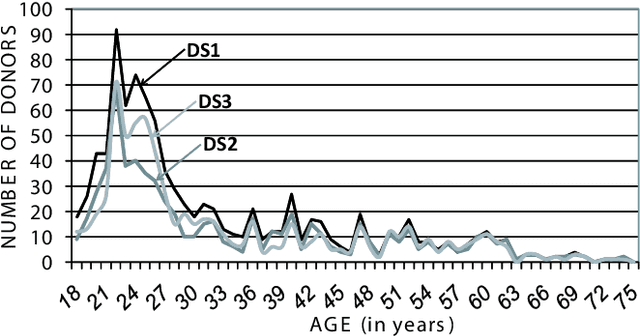


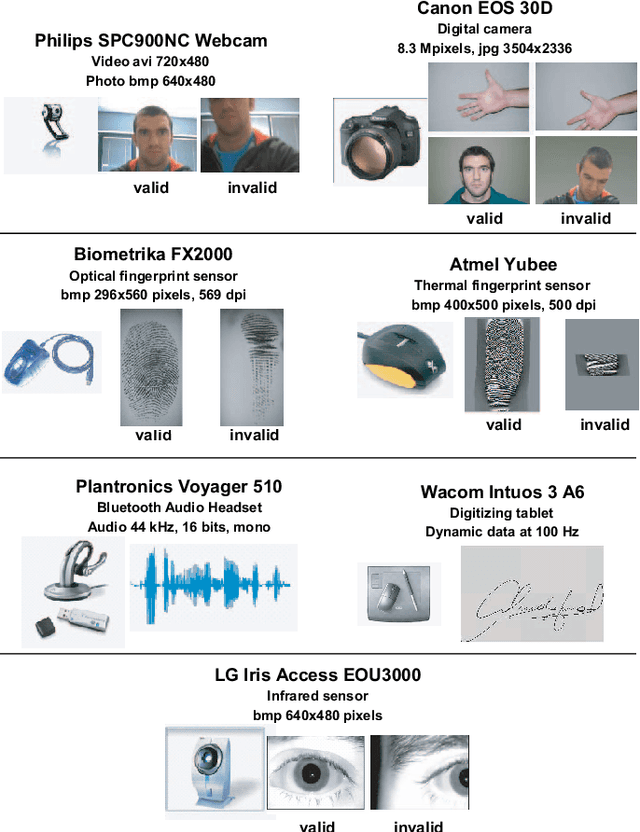
Abstract:A new multimodal biometric database designed and acquired within the framework of the European BioSecure Network of Excellence is presented. It is comprised of more than 600 individuals acquired simultaneously in three scenarios: 1) over the Internet, 2) in an office environment with desktop PC, and 3) in indoor/outdoor environments with mobile portable hardware. The three scenarios include a common part of audio/video data. Also, signature and fingerprint data have been acquired both with desktop PC and mobile portable hardware. Additionally, hand and iris data were acquired in the second scenario using desktop PC. Acquisition has been conducted by 11 European institutions. Additional features of the BioSecure Multimodal Database (BMDB) are: two acquisition sessions, several sensors in certain modalities, balanced gender and age distributions, multimodal realistic scenarios with simple and quick tasks per modality, cross-European diversity, availability of demographic data, and compatibility with other multimodal databases. The novel acquisition conditions of the BMDB allow us to perform new challenging research and evaluation of either monomodal or multimodal biometric systems, as in the recent BioSecure Multimodal Evaluation campaign. A description of this campaign including baseline results of individual modalities from the new database is also given. The database is expected to be available for research purposes through the BioSecure Association during 2008
A Comparative Study of Fingerprint Image-Quality Estimation Methods
Nov 14, 2021



Abstract:One of the open issues in fingerprint verification is the lack of robustness against image-quality degradation. Poor-quality images result in spurious and missing features, thus degrading the performance of the overall system. Therefore, it is important for a fingerprint recognition system to estimate the quality and validity of the captured fingerprint images. In this work, we review existing approaches for fingerprint image-quality estimation, including the rationale behind the published measures and visual examples showing their behavior under different quality conditions. We have also tested a selection of fingerprint image-quality estimation algorithms. For the experiments, we employ the BioSec multimodal baseline corpus, which includes 19200 fingerprint images from 200 individuals acquired in two sessions with three different sensors. The behavior of the selected quality measures is compared, showing high correlation between them in most cases. The effect of low-quality samples in the verification performance is also studied for a widely available minutiae-based fingerprint matching system.
BiosecurID: a multimodal biometric database
Nov 02, 2021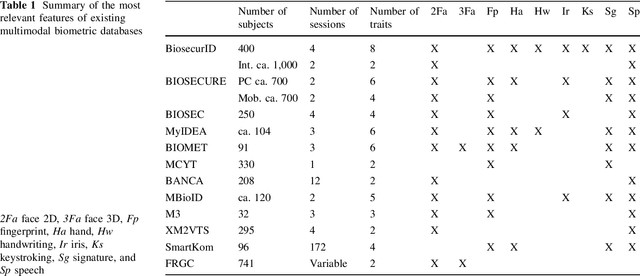
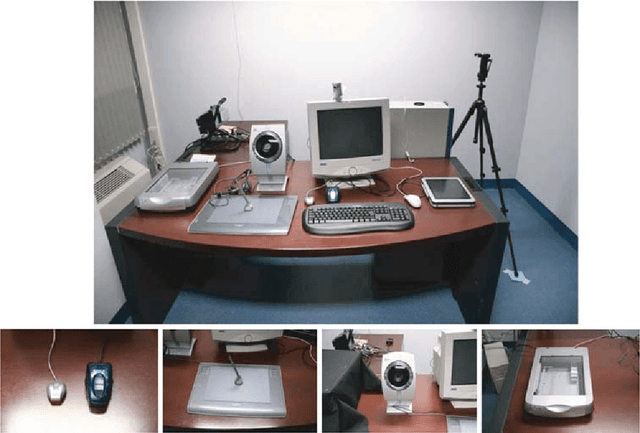
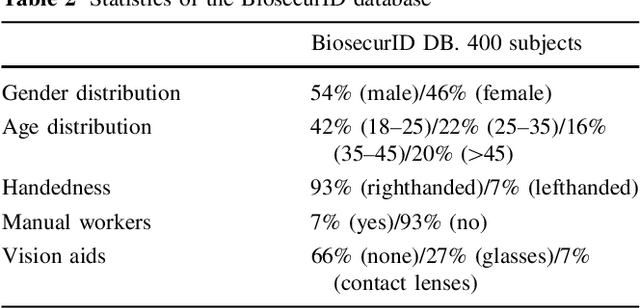
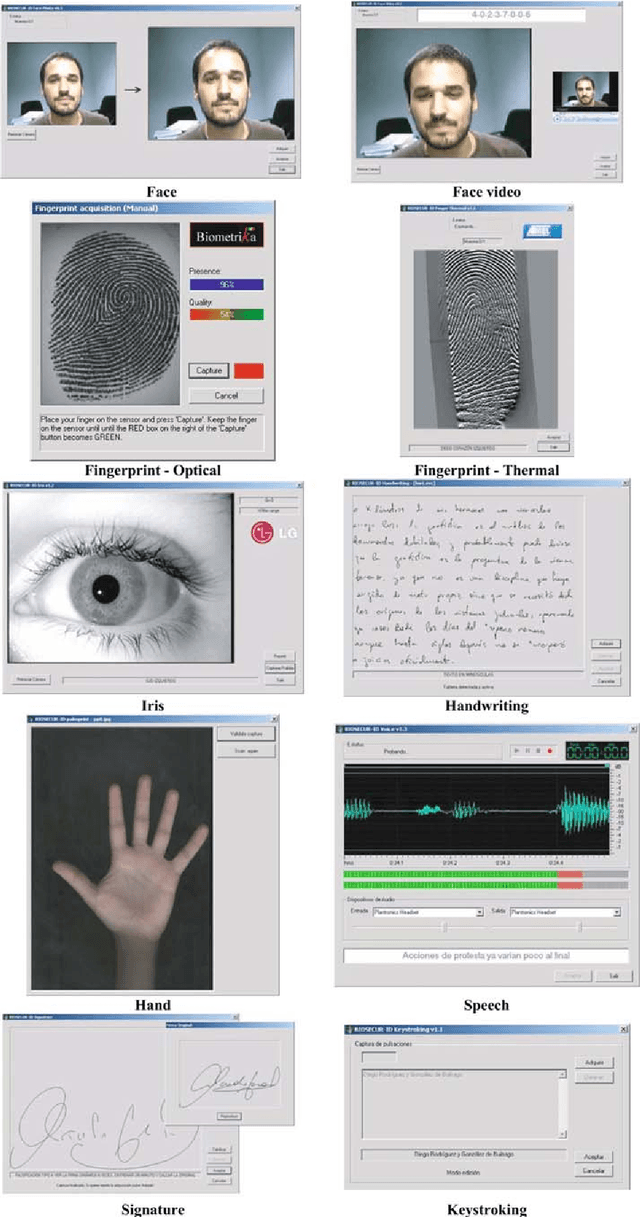
Abstract:A new multimodal biometric database, acquired in the framework of the BiosecurID project, is presented together with the description of the acquisition setup and protocol. The database includes eight unimodal biometric traits, namely: speech, iris, face (still images, videos of talking faces), handwritten signature and handwritten text (on-line dynamic signals, off-line scanned images), fingerprints (acquired with two different sensors), hand (palmprint, contour-geometry) and keystroking. The database comprises 400 subjects and presents features such as: realistic acquisition scenario, balanced gender and population distributions, availability of information about particular demographic groups (age, gender, handedness), acquisition of replay attacks for speech and keystroking, skilled forgeries for signatures, and compatibility with other existing databases. All these characteristics make it very useful in research and development of unimodal and multimodal biometric systems.
 Add to Chrome
Add to Chrome Add to Firefox
Add to Firefox Add to Edge
Add to Edge